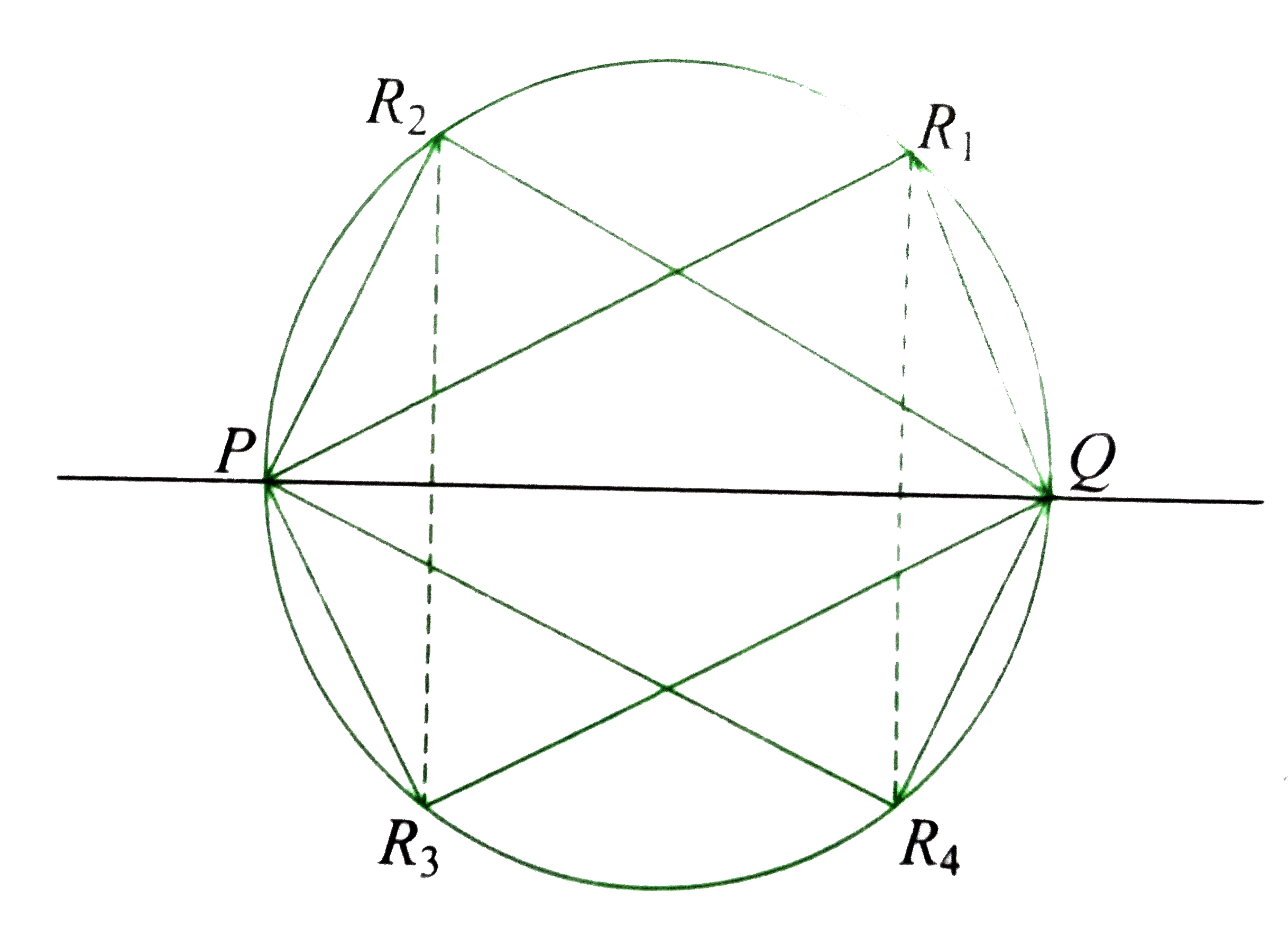If f:R→N∪{0}, where f (area of triangle joining points P(5,0),Q(8,4)andR(x,y) such that angle PRQ is a right angle = number of triangles, then which of the following is true? f(5)=4 (b) f(7)=0 f(6.25)=2 (d) f(x)is into
f(5)=4
f(7)=0
f(6.25)=2
f(4.5)=4
The correct Answer is:A, B, C, D
Hence∠PRQ=π/2 and points P, Q, R lie on the circle with PQ as diameter.
Also, PQ=5.

Now, the maximum area of the triangle is
Δmax=12(5)(52)=6.25
For area = 5, we have four symmetrical positions of point R (shown as R1,R2,R3,R4).
For area = 6.25, we have exactly two points.
For area = 7, no such points exist.
Topper's Solved these Questions
- RELATIONS AND FUNCTIONSBOOK - CENGAGE ENGLISHCHAPTER - RELATIONS AND FUNCTIONSEXERCISE - Linked Comprehension Type
32 Videos
- RELATIONS AND FUNCTIONSBOOK - CENGAGE ENGLISHCHAPTER - RELATIONS AND FUNCTIONSEXERCISE - Matrix Match Type
9 Videos
- RELATIONS AND FUNCTIONSBOOK - CENGAGE ENGLISHCHAPTER - RELATIONS AND FUNCTIONSEXERCISE - Single Correct Answer Type
125 Videos
- PROPERTIES AND SOLUTIONS OF TRIANGLEBOOK - CENGAGE ENGLISHCHAPTER - PROPERTIES AND SOLUTIONS OF TRIANGLEEXERCISE - Archives (Numerical Value Type)
3 Videos
- SCALER TRIPLE PRODUCTS BOOK - CENGAGE ENGLISHCHAPTER - SCALER TRIPLE PRODUCTS EXERCISE - DPP 2.3
11 Videos
Similar Questions
Knowledge Check
Which one of the following is the second degree polynomial function f(x), where f(0)=5f(−1)=10andf(1)=6=?
A5x2−2x+5B3x2−2x−5C3x2−2x+5D3x2−10x+5
If equation f(x)=x4−ax3+bx2−cx+420 have all roots integer and greater than 1. Given that f(4)=0, then f(−4)=0 (b) f(8)=60 f′(4)=3 (d) f′(3)=−8
View SolutionGiven the function f(x) = 2x + 7. Find f(0), f(5), f(7).
View SolutionLet f:[0,1] → R be a function.such that f(0)=f(1)=0andf''(x)+f(x)≥ex for all x∈[0,1].If the fucntion f(x)e−x assumes its minimum in the interval [0,1] at x=14 which of the following is true ?
View SolutionLet f(x) is a differentiable function on x∈R, such that f(x+y)=f(x)f(y) for all x,y∈R where f(0)≠0. If f(5)=10,f'(0)=0, then the value of f'(5) is equal to
View SolutionIf ABC and DEF are two triangles such that ABC ≅FDE and AB=5cm, ∠B=400 and ∠A=800. Then, which of the following is true? (a)DF=5cm, ∠F=600 (b) DE=5cm, ∠E=600 (c)DF=5 cm, ∠E=600 (d) DE=5cm, ∠D=400
View SolutionLet f:[0,1]→R (the set of all real numbers) be a function. Suppose the function f is twice differentiable, f(0)=f(1)=0 and satisfies f'(x)−2f'(x)+f(x)≥ex,x∈[0,1] If the function e−xf(x) assumes its minimum in the interval [0,1] at x=14, which of the following is true?
(A) f'(x)<f(x),14<x<34
(B) f'(x)>f(x),0<x<14
(C) f'(x)<f(x),0<x<14
(D) f'(x)<f(x),34<x<1
View SolutionLet f:[0,1]→R (the set of all real numbers) be a function. Suppose the function f is twice differentiable, f(0)=f(1)=0andsatiiesf\'\'(x)-2f\'(x)+f(x) ge e^x, x in [0,1]Ifthefunctione^(-x)f(x)as∑esitsminiμm∈the∫erval[0,1]atx=1/4,whichofthefollow∈gistrue?(A)f\'(x) lt f(x), 1/4 lt x lt 3/4(B)f\'(x) gt f(x), 0<x<14 (C) f'(x)<f(x),0<x<14 (D) f'(x)<f(x),34<x<1
View Solution
